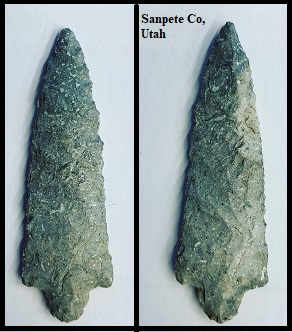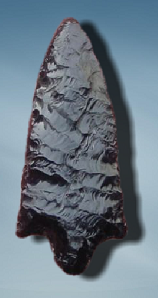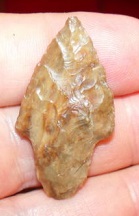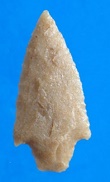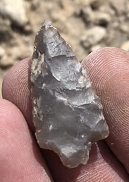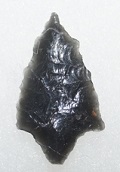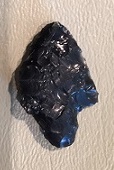Outline is Representative of Size and Shape:

Name Details:
Identified By: Robert E. Harrington
Named For: Type Site
Date Identified: 1933
Type Site: Gypsum Cave (near Las Vegas), Nevada
Identified By: Robert E. Harrington
Named For: Type Site
Date Identified: 1933
Type Site: Gypsum Cave (near Las Vegas), Nevada
Point Validity:
Valid type
Harrington excavated the Gypsum Cave site in Nevada. These points were named for this site. Since that time they have been re-defined by Robert H. H. Franks in 1944 and Richard Homer in 1986. This is considered a valid type.
Harrington excavated the Gypsum Cave site in Nevada. These points were named for this site. Since that time they have been re-defined by Robert H. H. Franks in 1944 and Richard Homer in 1986. This is considered a valid type.
Gypsum Cave Stemmed
AKA: Park Point (Stewart)Lobo (Berry)
Cluster: Gypsum Cave Cluster
Description of Physical Characteristics and Flaking Pattern:
This is a medium point with a flattened to elliptical cross section. The blade ranges from straight to excurvate and may be serrated. The shoulders are most commonly at an upward angle, but may be horizontal to barbed. The most notable characteristic for this point is the contracting stem with the convex base. Basal grinding is generally absent on this point. This point has a random flaking pattern.
Size Measurements:
Total Length - 34 to 59 mm (average 42 mm), Stem Length -7 to 14 mm, Blade Width - 19 to 27 mm (average 24 mm), Stem Width at Shoulders - 6 to 16 mm, Basal Width - 1 to 5 mm, Thickness 4 to 8 mm
Total Length - 34 to 59 mm (average 42 mm), Stem Length -7 to 14 mm, Blade Width - 19 to 27 mm (average 24 mm), Stem Width at Shoulders - 6 to 16 mm, Basal Width - 1 to 5 mm, Thickness 4 to 8 mm
Commonly Utilized Material:
Additional Comments:
Gypsum points are unique in the Archaic period because they may represent a change in hafting technology.
These points are though to have originated in Mexico (7,000 B.P) and migrated north into the Great Basin. (Marmaduke, 1978).
Due to the multitude of names and referring to this point as other types, this point has been included in the following complexes / periods / phases: Newberry Period, Pinto Gypsum Complex, Early and Middle Rose Springs Period, Armargosa I and III, Death Valley II, Ray Phase. (Des Planques, 2001).
For many years all contracting stem projectile points found in the Great Basin and on the Colorado Plateau were considered Gypsum point. As further analysis of these points was conducted, these points have been divided into other points based on the techniques and technology used (Justice, 2002). Many points have been identified and separated from the Gypsum point, but many people still use the Gypsum type for contracting stem points.
Gypsum points are unique in the Archaic period because they may represent a change in hafting technology.
These points are though to have originated in Mexico (7,000 B.P) and migrated north into the Great Basin. (Marmaduke, 1978).
Due to the multitude of names and referring to this point as other types, this point has been included in the following complexes / periods / phases: Newberry Period, Pinto Gypsum Complex, Early and Middle Rose Springs Period, Armargosa I and III, Death Valley II, Ray Phase. (Des Planques, 2001).
For many years all contracting stem projectile points found in the Great Basin and on the Colorado Plateau were considered Gypsum point. As further analysis of these points was conducted, these points have been divided into other points based on the techniques and technology used (Justice, 2002). Many points have been identified and separated from the Gypsum point, but many people still use the Gypsum type for contracting stem points.
Distribution: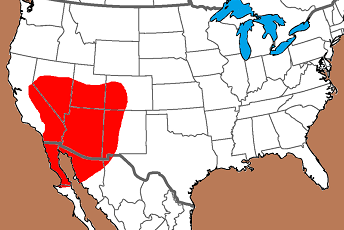

Distribution Comments:
This point is found throughout the southern Great Basin and the southern Colorado Plateau into the southwestern region and into northern Sonora and northern Baja California, Mexico. This type was reported at the La Playa site in northern Sonora, Mexico.
This point is found throughout the southern Great Basin and the southern Colorado Plateau into the southwestern region and into northern Sonora and northern Baja California, Mexico. This type was reported at the La Playa site in northern Sonora, Mexico.
Age / Periods:
Date: 4,000 - 2,800 B.P.
Cultural Period: Late Archaic
Glacial Period: Neoglacial
Culture: Oshara Tradition
Date: 4,000 - 2,800 B.P.
Cultural Period: Late Archaic
Glacial Period: Neoglacial
Culture: Oshara Tradition
Age Details:
Pinto Gypsum Complex
Coxcatlin, Chiricahua Phase
Pinto Gypsum Complex
Coxcatlin, Chiricahua Phase
Similar Points:
Augustin, Cliffton, Coquille, Coxtanlan, Desmuke, Gatecliff, Garyito, Hayes Grande, Houx, La Mina, La Paz, Langtry Arenosa, Manzano, Manuela, Val Verde, Parowan, Perdiz, Ranilla, Salado, San Martin, Santa Cruz, Shumla, Tlatilco, Trinidad
Augustin, Cliffton, Coquille, Coxtanlan, Desmuke, Gatecliff, Garyito, Hayes Grande, Houx, La Mina, La Paz, Langtry Arenosa, Manzano, Manuela, Val Verde, Parowan, Perdiz, Ranilla, Salado, San Martin, Santa Cruz, Shumla, Tlatilco, Trinidad
Other points in this cluster / Related / Associated Points:
Pinto Basin
Pinto Basin

